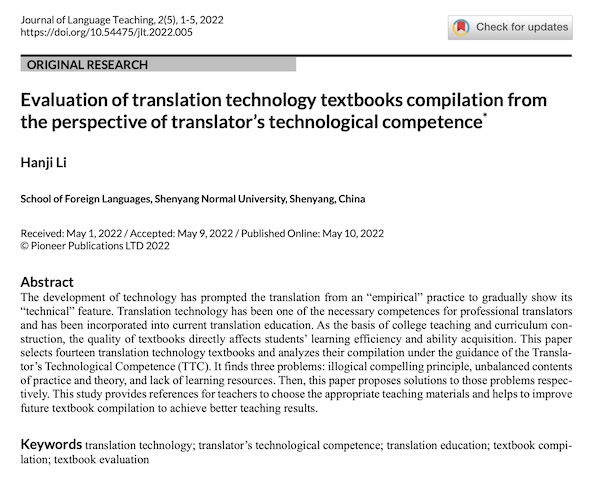Evaluation of translation technology textbooks from the perspective of translator’s technological competence
DOI:
https://doi.org/10.54475/jlt.2022.005Keywords:
translation technology, translator’s technological competence, translation education, textbook compilation, textbook evaluationAbstract
The development of technology has prompted the translation from an “empirical” practice to gradually show its “technical” feature. Translation technology has been one of the necessary competences for professional translators and has been incorporated into current translation education. As the basis of college teaching and curriculum construction, the quality of textbooks directly affects students’ learning efficiency and ability acquisition. This paper selects fourteen translation technology textbooks and analyzes their compilation under the guidance of the Translator’s Technological Competence (TTC). It finds three problems: illogical compelling principle, unbalanced contents of practice and theory, and lack of learning resources. Then, this paper proposes solutions to those problems respectively. This study provides references for teachers to choose the appropriate teaching materials and helps to improve future textbook compilation to achieve better teaching results.
References
Beeby, A. (2000). Evaluating the development of translation competence. In C. Schäffner & B. Adab (Eds.), Developing Translation Competence (pp. 185-198). John Benjamins. https://doi.org/10.1075/btl.38.01sch DOI: https://doi.org/10.1075/btl.38.18bee
Bell, R. (1991). Translation and translating. Longman.
Bowker, L. (2002). Computer-aided translation technology: A practical introduction. University of Ottawa Press. DOI: https://doi.org/10.1353/book6554
Chen, S. (2014). New horizons in translation technology. Tsinghua University Press.
Holmes, J. S. (1988). Translated! Papers on literary translation and translation studies. Rodopi: 67-80. https://doi.org/10.1163/9789004486669_008 DOI: https://doi.org/10.1163/9789004486669
Ivanova, O. (2016). Translation and ICT competence in the globalized world. Procedia-Social and Behavioral Sciences, 231, 129-134. https://doi.org/10.1016/j.sbspro.2016.09.081 DOI: https://doi.org/10.1016/j.sbspro.2016.09.081
Kiraly, D. C. (2003). A passing fad or the promise of a paradigm shift in translator education? In B. J. Baer & G. S. Koby (Eds.), Beyond the Ivory Tower: Rethinking Translation Pedagogy.
Kong, L., & Cui, Q. (2018). On the Influence of Information Technology on Translation. Journal of Beijing International Studies University, 40(3), 44-57. https://journal.bisu.edu.cn/EN/10.12002/j.bisu.157
Miao, J., & Wang, S. (2010). MTI Education in light of a survey on employment trend in translation industry. Foreign Languages and Their Teaching, 3(1), 63-67. https://doi.org/10.13458/j.cnki.flatt.000224
Neubert, A. (2000). Competence in language, in languages, and in translation. In C. Schäffner & B. Adab (Eds.), Developing Translation Competence (Vol. 38, pp. 3-18). John Benjamins. https://doi.org/10.1075/btl.38.03neu DOI: https://doi.org/10.1075/btl.38.03neu
PACTE. (2005). Investigating translation competence: Conceptual and methodological issues. Meta, 50(2): 609-619. https://doi.org/10.7202/011004ar DOI: https://doi.org/10.7202/011004ar
Ren, D. L. (2013). Project-based course mode of translation competence development. Technology Enhanced Foreign Language Education, (3): 42-48.
Wang, H. S. (2017). MTI education innovation and localization talent cultivation in the age of translation professionalization. Journal of Foreign Languages, (5): 111-112.
Wang, H. S., Li, D. F., & Li, L. Q. (2018). Translation technology teaching in MTI programs in China: Problems and suggestions. Technology Enhanced Foreign Language Education, (3): 76-82, 94.
Wang, S. & Qin, J. (2018). Constructing technological competence system for translators in the context of big data. Technology Enhanced Foreign Language Education, (1): 90-96.

Downloads
Published
Issue
Section
License
Copyright (c) 2022 Journal of Language Teaching

This work is licensed under a Creative Commons Attribution 4.0 International License.




